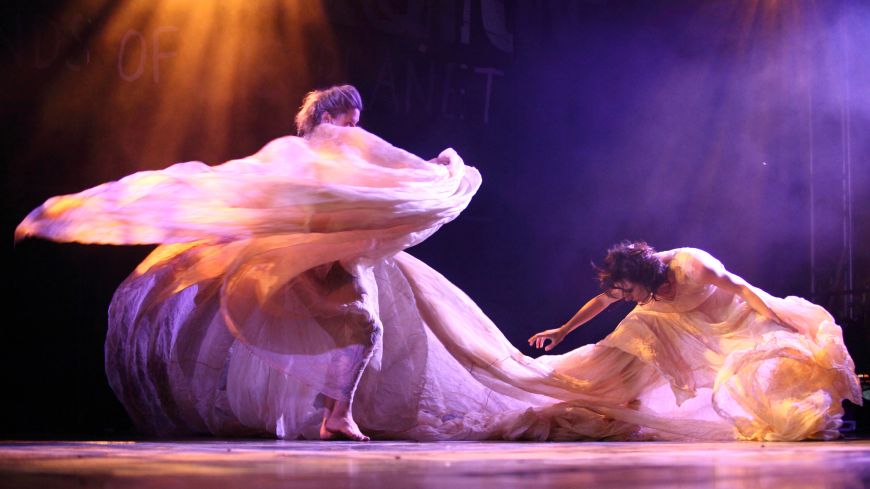
In this double bill, we observe contrasting dance pieces – one a European premiere – by two of Australia’s renowned choreographers, Leigh Warren and Frances Rings. Live music is an integral part of the Leigh Warren + Dancers company, which Warren experienced and appreciated during his time working with Ballet Rambert and NDT.
At the start of Breathe, William Barton, a master of the didjeridu, took his place at the front of the stage. He learnt to play from his Aboriginal uncle, a tribe elder in Western Queensland; for this dance piece he is the composer and performer of the music arranged for didjeridu, guitar and vocals. The choreographer is Frances Rings who is half Aboriginal, half German.
First the sound of breathing, as the slow, reverberating humming, strumming musical notes provide the rhythm and pace for movement. The stage is dark, then from the back emerge five dancers, dressed in thin grey-green tie-dyed cotton dresses and shorts. They crouch together as if in fear, creeping further forward, as haunting vocals fill the air. They dance in a tribal ring, followed by a sensual solo performance.
Shifting the mood in an artistically beautiful scene, two girls twirl and whirl while joined together wearing the same long, extended white dress, the fabric billowing like clouds around and above them.
Lighting begins in soft shadows with a burst of sparkling fireflies, finally breaking into a golden glow of sunrise, recreating a natural outdoor space, the wilderness in the Outback. The music intensifies with a recorded soundtrack of drum beats matching an increased energy of movement, as the screech of the didjeridu evokes a cry for freedom.
This fine collaboration of Barton and Rings is a truly authentic celebration of their Australian Aboriginal ancestry through tribal culture, music and dance.
In the second piece, “Impulse” by Leigh Warren, live music by the Zephyr Quartet literally takes over the stage. Four stools and music stands are set up in a square by the dancers for the performance of Michael Nyman’s String Quartet no. 2. Like the Quartet, the dancers are dressed in black – cocktail dress, trousers and shirts, almost camouflaged in the low light, moving around and amidst the musicians.
The music is fast and furious, the bows sawing the strings to a rhythmic beat reminiscent of Scottish Jig, as the dancers skip, jump and jive together. But it’s the power and pulse of the music and performance of the Quartet on which I concentrate. I am almost oblivious to the choreography which at times appears awkward as the dancers weave in and out, trying not to knock over a music stand.
This is essentially a superlative performance of Nyman’s String Quartet, with a dance ensemble lost in the background. Having witnessed sublime grace and serenity of movement in “Breathe”, it was a shame that Warren’s choreographic direction did not allow his dancers to shine in “Impulse”.
Event: 25-26 August 2012

